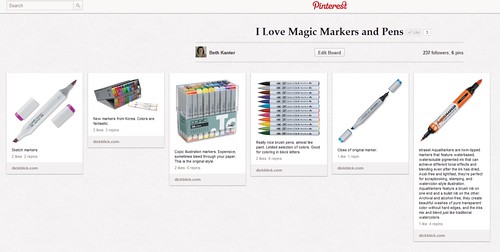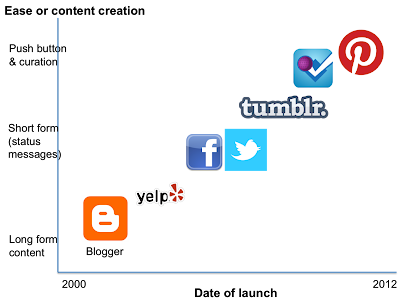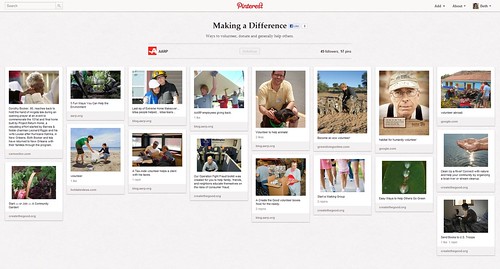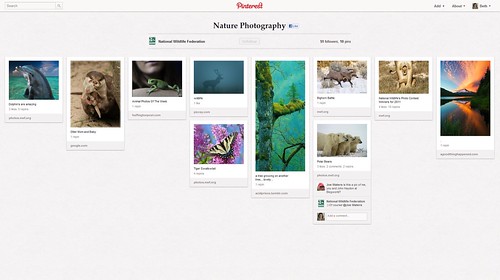
Pinterest is a virtual pinboard where you can organize and share images and videos you discover on the web. Think of it as social network of visuals – where you can find images from other people with the same interest or use it to curate your own visual “interest space.”
The clean interface and simplicity of its features make it easy to use and gives you a calm feeling which perhaps accounts for its popularity. At first glance, the site attracts people interested in using it for non-work interests, such as wedding planning, decorating, scrapbooking, and family photos, but brands and nonprofit professionals are also using it to curate information related to professional and organizational topics in a visually pleasing way. But if you want to be successful, you must curate and share relevant content.
I am visual learner and I’ve been a content curator for years. I was drawn to Pinterest because the functionality is exactly how I’ve been using my flickr account for years, but makes it easier to share images you’ve found from other web sites and people. I created several pins based on professional interests and a few personal topics. My most popular pin is a collection of nonprofit infographics, but the second best one is a personal one, “I Love Magic Markers.” Here’s the number of followers for each pin:
Nonprofit Infographics (287)
Social Media and Nonprofit Book Recommendations (250)
I Love Magic Markers (237)
Social Media Best Practices (215)
African Fabrics (115)


My strategy for content curation will be highly selective and focus more on quality than quantity. And to have these images linked to more contextual information beyond the image source. For example, to my blog posts on the topic. Who knows maybe Rafe Needleman’stongue in check “prediction” that Google + will acquire Pinterest and that might actually make it more useful.

The Big Picture
Pinterest is a small example of how the social web is evolving. There is so much content being created and shared, that making sense of it is getting harder and harder unless you have context. This is what content curation does – it joins your social graph with interest graphics. It’s explained in more detail in this TechCrunch post, The Age of Relevance. Several of the newest social platforms create “interest graphs” a map for navigating to subjects and people of interest. The Interest graph is a superset of the social graph, a people map. The interest graph includes people, things, and their linkages and it helps users navigate the information thicket. Content Curators are doing this and more platforms will facilitate curation. Pinterest is one of them.
The difference between content shared through social graphs is that sharing is a stream. That can feel overwhelming and hard to organize when lots of categorical pieces of content fly by you . The tools that create interest graphs, the curation tools, allow you to put some structure and that’s what provides the context. It is also part of what makes pinterest and other curation tools so addictive.
But remember, as Nancy Schwartz points, Relevance Rules! in her advice about campaigns, you need to be strategic about what content you’re curating and WHO you’re sharing with. Content curation should link to your integrated strategy objectives and identified audience. Otherwise, you’re wasting your time playing with a pretty shiny object.
Nonprofit Uses Pinterest
Joe Waters wrote an interesting piece in the Huffington Post about Pinterest and nonprofits. He points out that it is an audience he wants to reach with his cause marketing information:
It’s easy to use, powerfully visual, populated with cause marketing-loving women and growing like crazy. 4,000 percent in six months!
The heavy presence of women 25-44 on Pinterest is what distinguishes it from other new social media platforms, which are generally populated by men 18-24. Here’s a site that already has the audience everyone wants: women and moms who make most of the household buying decisions.
Joe also asks a few good starter questions if your nonprofit is considering setting up a presence:
- Do you have an interesting or compelling story to tell with images?
- Is your cause considered hip, trendy, or do you just want to be?
- Are you engaged on other social media platforms?
- Are you looking to reap the rewards of local SEO?
I’d add to this some questions about measurable objectives and who is the target audience.

Several Nonprofits are experimenting with Pinterest. AARP has several boards related to it content, including “Over 50 Making a Difference. ” Amnesty International has set up a list of book recommendations, “Human Rights Reading.” National Wildlife Federation is curating wildlife photos and other visually related content.

Help Attack has created this demo video about how to use for fundraising.
Joe offers some guidelines for using the site:
- Be useful
- Pinterest users are looking for ideas and inspiration.
- Create categories that reflect what users are looking for.
- Give the job to someone who has an eye for aesthetics.
- Learn from these 15 Pinterest superusers.
- Don’t just pin, repin.
- Let your supporters pin for you.
- Add “pin it” buttons to your blog or web site so your visitors and supporters can create their own pin boards that highlight your cause.
If you decide to set up a board, here’s some useful tips from Mashable and this analysis of the top brands on Pinterest and some more ideas about how to use for your organization. Or just wait until the Pinterest for Dummies book publishes. While the user base is predominantly female, there are guys there too.
I’ve set up a resource sheet with more examples, tips, and links here.
Special thanks to: Nancy Schwartz, Zan Mccolloch-Lussier, Maddie Grant, Stephanie Scwab, Amy Sample Ward, Alejandra Owns, Jen Martin, Tammy Gordon, Melanie Mathos, Chad Norman, Michael DeLong, Debra Asknase, Janet Fouts, Kyra Stoddart, Marc Sirkin and Sue Anne Reed for sharing their insights about Pinterest.
Is your organization curating content as part of a strategy to be relevant to your audience? What you think of Pinterest? Jumping in or watching from the sidelines?
What are your nonprofit’s strategies for incorporating content curation? Do you think pinterest might be useful to your organization? How will you use it strategically?
